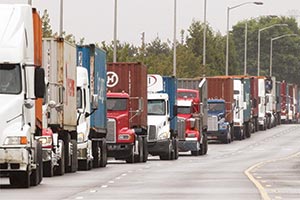Senior Reporter
Report: Traffic to Worsen Without Federal Fund Lift

This story appears in the May 16 print edition of Transport Topics.
The rate at which trucks will be stuck in traffic will increase dramatically over the coming years if poor highway infrastructure is not rehabilitated, a new report by the American Society of Civil Engineers concluded.
“It’s more difficult to get things to markets, either internationally or domestically,” when trucks have trouble accessing ports and distribution centers due to congestion, Steven Landau, director of transportation and development at Economic Development Research Group, told Transport Topics.
Landau collaborated with ASCE on the report, released May 10.
“What we found is that the increase of the cost of truck transportation leads to an increased business cost, which leads to an increase of the price of products, which makes U.S. products that are transported by trucks less competitive with international competitors,” Landau said.
In a separate report that examined interconnectivity, the U.S. Department of Transportation reached the same findings, determining that truck traffic is estimated to increase by 60% over the next three decades. The increase would stem largely from an affinity for shopping online.
ASCE’s report will help frame the national conversation on infrastructure during weeklong discussions beginning May 16. Transportation and infrastructure stakeholders will take part in panels and workshops in Washington and around the country for what’s billed as Infrastructure Week. Heavy traffic in general causes wear and tear on roads and bridges, and according to the ASCE report, higher costs for infrastructure repairs are likely to reduce business demand. That will lead to reductions in business income and profits, and ultimately to layoffs and lower personal income for employees, it said.
The organization in its 2013 quadrennial report card said the country had earned a D+ grade for its infrastructure. It plans on unveiling the new report card next year.
ASCE said a $3.3 trillion investment within the next decade will be needed to bring the country to a state of good repair. Those investments would need to nearly double the $1.8 trillion in estimated planned infrastructure spending during that time. It has argued that if the gap in infrastructure investment is not shrunk, the economy is likely to lose almost $4 trillion in gross domestic product and 2.5 million jobs. Those infrastructure deficiencies could cost each household about $3,400 annually in disposable income over the next 10 years, the report said, if structural inefficiencies are not addressed.
Despite the recent passage of the five-year FAST Act highway law, the transportation investment funding gap will grow to $5.1 trillion by 2040, assuming the rate of investment does not increase, according to ASCE’s report.
Greg DiLoreto, past president and chairman of the group’s Committee for America’s Infrastructure, stressed a sense of urgency to back large-scale roadway projects: “The longer you wait to repair it, the closer you get to having to replace it.”
ASCE estimates the rate of roadway congestion boosts the case for expanding capacity along freight corridors. As of 2015, estimated deficiencies along surface transportation systems cost individual taxpayers and businesses nearly $147 billion, the report said. The water and wastewater sectors likely will see a $105 billion investment gap.
“Increased congestion decreases the reliability of transportation facilities,” the report said, meaning less reliable water and electricity, and unmet maintenance needs and outdated facilities of airports, marine ports and on inland waterways and the freight network.
It also means poorer road conditions, which “lead to increases in operating costs for trucks, cars and rail vehicles.”
The American Transportation Research Institute last month released results from its survey that found the country’s collective congestion accounted for close to $50 billion in operational costs for the trucking industry in 2014. It said its analysis “demonstrates the impact of congestion costs on a per-truck basis, with an average increased cost of $26,625 for trucks that travel 150,000 miles annually.”
ATRI said more than a dozen states experienced increased costs of more than $1 billion each due to congestion, with Florida and Texas leading with more than $4 billion each.
ASCE also examined investments in surface transportation, wastewater, electricity, water, airports, waterways and ports. Investments increased slightly or remained stable for those sectors. But the investments are insufficient, DiLoreto told reporters, adding that Congress should consider raising federal fuel taxes to fund infrastructure projects. The federal tax on diesel fuel is 24.4 cents a gallon, and for gasoline, it is 18.4 cents a gallon.
“Every day we delay in making a significant investment, the more we fall behind,” DiLoreto said.


